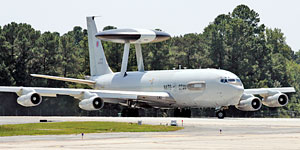NATO airmen training at SJAFB
By Kenneth Fine
Published in News on August 13, 2008 1:39 PM
Enemy fighters are nearing the North Carolina coast.
A four-ship of F-15E Strike Eagles knows it must protect the home front.

News-Argus/Bobby Williams
An E-3 Sentry from NATO Air Base Geilenkirchen, Germany, taxis down the Seymour Johnson Air Force Base flight line Tuesday afternoon before taking off for a four-hour training sortie. An asset of the NATO Airborne Early Warning and Control Force E-3A Component's Flying Squadron 2, the $270 million
aircraft is an airborne warning and control system (AWACS).
But getting a read on the enemy is not a charge left only to those 335th Fighter Squadron air crews en route from Seymour Johnson Air Force Base.
Somewhere in the air space above them, another aircraft is "running the show" -- marking targets, assessing threats.
It's a NATO E-3 Sentry.
"We have no idea what the threat is going to do. That's part of the training," said 335th Capt. Nick Suppa. "(The NATO crew), they give us the big picture of what the threat is doing to us."
An E-3 from NATO Air Base Geilenkirchen, Germany, touched down at Seymour Johnson late Friday evening, and since, has been working hand-in-hand with members of the 335th.
An asset of the NATO Airborne Early Warning and Control Force E-3A Component's Flying Squadron 2, the $270 million aircraft is an airborne warning and control system (AWACS) that provides all-weather surveillance, command, control and communications needed by commanders of U.S. and NATO air defense forces.
Lt. Col. Tim Brester, director of operations for the squadron, called the two-week deployment "self-generated" and said he believes it will provide his 29-man crew with an opportunity to learn from fighter air crews during face-to-face briefs and debriefs.
"These guys had a need for the training, and we wanted to do the training," he said. "This was us getting together and saying, 'Hey, I think we can both mutually benefit from this.'"
Suppa said the experience he and fellow members of the 335th expect to get from training with the E-3 could come in handy during future deployments.
After all, the voices of AWACS crews are some of the first fighter crews hear when they take off in theater.
"They are an essential component of the command and control structure in Afghanistan," Suppa said. "When we take off, we are speaking directly with their controllers."
A 30-foot dome sits atop of the E-3. It contains the million-watt, Doppler Radar System that permits surveillance from the Earth's surface up into the stratosphere, over land or water. The radar has a range of more than 200 miles, and, combined with an identification friend or foe subsystem can look down to detect, identify and track enemy and friendly low-flying aircraft by eliminating ground clutter returns that confuse other radar systems.
That technology has been in full force the past few days during Surface Attack Tactics (SAT) training, Suppa said.
"Usually we will go out with a four-ship. We'll have a ground target. Our normal flow would be to fight our way in, destroy the target and fight our way out," he said. "The crew in that E-3, they are providing a big picture to us of the air-to-air scenario. They help us locate that target and, once it's destroyed, they give us an idea of what the enemy is doing."
In support of air-to-ground operations, the Sentry can provide direct information needed for interdiction, reconnaissance, airlift and close-air support for friendly ground forces, Brester said. It can also provide information for commanders of air operations to gain and maintain control of the air battle.
"The mission of AWACS is command and control," he said. "That's working with fighter guys, doing air-to-air stuff, tanker guys, talking to and coordinating with guys on the ground. Ultimately, our job is air battle management. That's what we do. We talk to these guys -- get them on the right target at the right time. ... We use our sensors to make that all happen."
During the remainder of Flying Squadron 2's stay, many members of the 335th will get the chance to fly in the E-3 -- to see faces behind the voices typically on the other end of a cockpit call in action.
Suppa called it "invaluable."
"The ability for us to work with them here at our home station, it builds a relationship and a rapport you can't get just by working airborne only," he said. "For us to be able to work with all these other people, it only makes us better."
Brester agrees.
"We're coming over here representing ... the E-3 for NATO," he said. "The relationships we build now will enhance our ability to execute later. But for us, this is really about building that relationship and realizing that this is training you can't get in a school."
